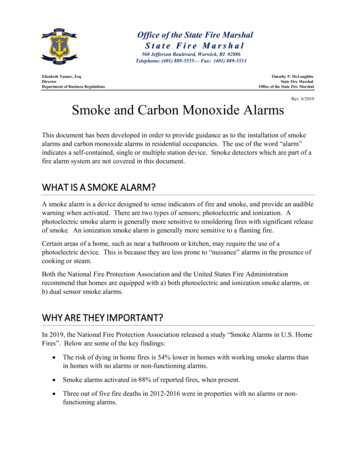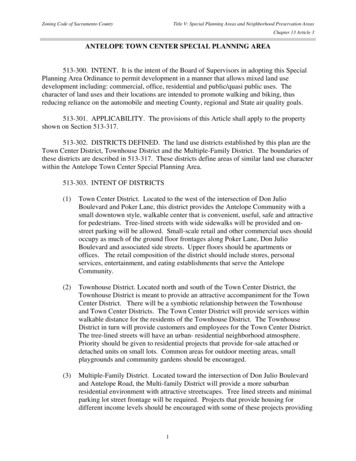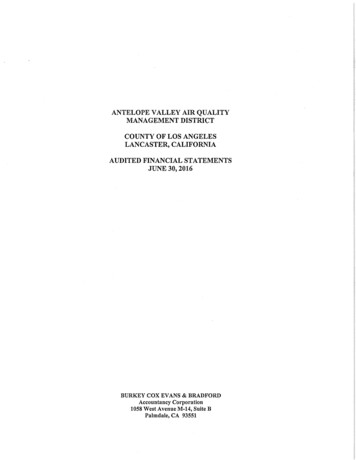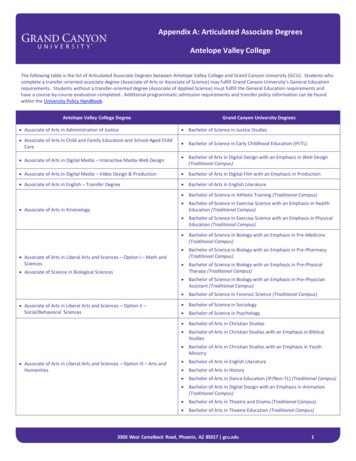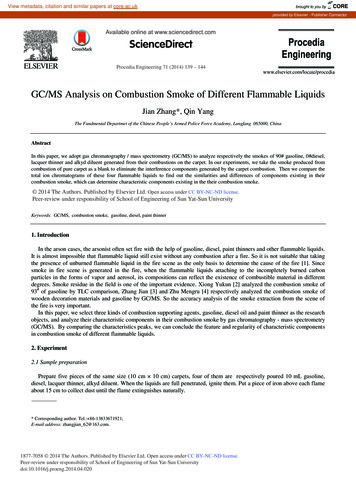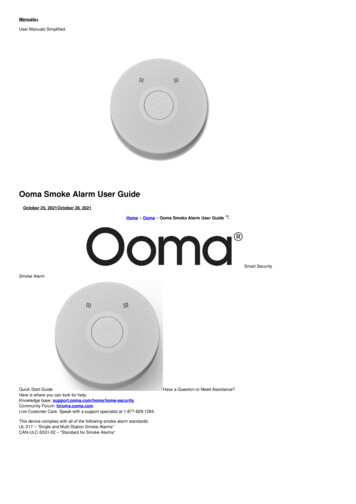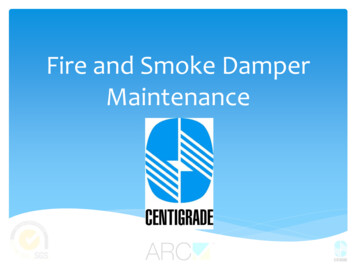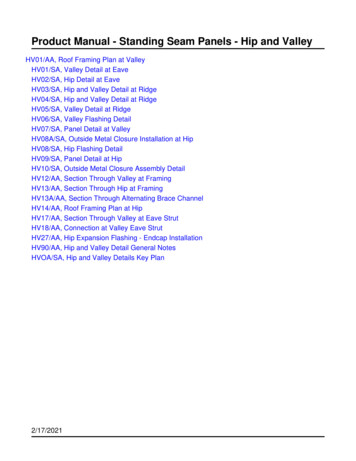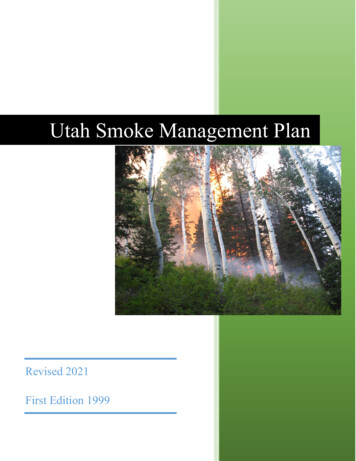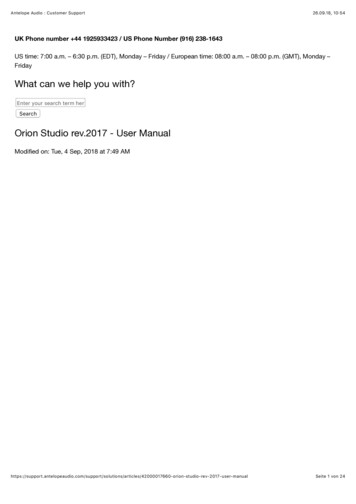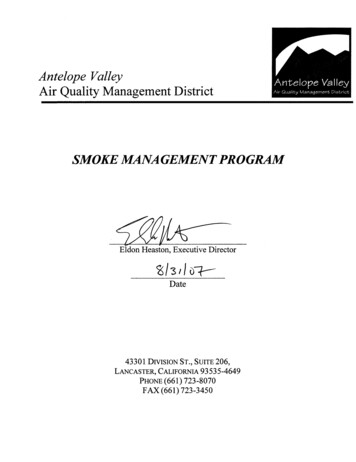
Transcription
Antelope ValleyAir Quality Management DistrictSMOKE MANAGEMENT PROGRAMEldon Heaston, Executive Director8/ 31 107Date43301 DIVISION ST., SUITE 206,LANCASTER, CALIFORNIA 93535-4649PHONE (661) 723-8070FAX (661) 723-3450Antelope ValleyAir Quality Management District
This page intentionally left blank.
TABLE OF CONTENTSSmoke Management ProgramI.INTRODUCTION AND BACKGROUND .DISTRICTINFORMATION.:"'A.B. PROGRAM INTENT AND DISTRICT RULES .C. DISTRICT AUTHORITY .4.4.*4.* 4:454954:54945:"545:""D. PUBLIC OUTREACH AND COMMENT PROCESS .E. FUTURE DISTRICT PLANNED ACTIONS .II.DEFINITIONS AND ACRONYMS."A. DEFINITION OF AGRICULTURAL BURNING .B. ACRONYMS .III.SMOKE MANAGEMENT PROGRAM .A.BURN PERMITS.".""B.BURN REGISTRATION AND REPORTING .BURN AUTHORIZATION SYSTEM.SMOKE MANAGEMENT PLANNING .DISTRICT RESOURCES ."F. INSPECTION AND ENFORCEMENT .Appendix A - Air District Burn Permit Application .C.D.E.Appendix B - Smoke Management Plan (SMP) Application For Burn Permit .Appendix C - Daily Authorization Request and Information Reporting Form .WWNNNNAA.4in. 6. 11. 12. A-1. B-1. C-1Appendix D - Controlled Burn and Prescribed Fire Notification Form ."; D IAVAQMD Smoke Management ProgramTC-1
This page intentionally left blankTC-2AVAQMD Smoke Management Program
ANTELOPE VALLEY AIR QUALITY AIR MANAGEMENT DISTRICTSmoke Management ProgramI.INTRODUCTION AND BACKGROUNDA.DISTRICT INFORMATIONThe Antelope Valley Air Quality Management District (AVAQMD or District)has jurisdiction over the northern, desert portion of Los Angeles County (SeeHealth & Safety Code 41300 and AVAQMD Rule 103). This region includesthe incorporated cities of Lancaster and Palmdale, Air Force Plant 42, and thesouthern portion of Edwards Air Force Base. The Kern County-Los AngelesCounty boundary forms the northern boundary of the District; the San BernardinoLos Angeles County boundary forms the eastern boundary of the District.As of 2005, the District has a population of approximately 400,000 people.The District is one of four air pollution control districts that have all or portions oftheir jurisdictions within the Mojave Desert Air Basin (MDAB; 17 Cal. Code Reg. 60109). The four districts within the MDAB are: the Kern County Air PollutionControl District, the South Coast Air Quality Management District, the MojaveDesert Air Quality Management District, and the AVAQMD.The District covers a western portion of the Mojave Desert Air Basin (MDAB).The MDAB is an assemblage of mountain ranges interspersed with long broadvalleys that often contain dry lakes. Many of the lower mountains that dot the vastterrain rise from 1,000 to 4,000 feet above the valley floor. Prevailing winds in theMDAB are out of the west and southwest. These prevailing winds are due to theproximity of the MDAB to coastal and central regions and the blocking nature ofthe Sierra Nevada Mountains to the north; air masses pushed onshore in SouthernCalifornia by differential heating are channeled through the MDAB. The MDABis separated from the southern California coastal and central California Valleyregions by mountains (highest elevation approximately 10,000 feet), whose passesform the main channels for these air masses. The Antelope Valley is bordered inthe northwest by the Tehachapi Mountains, separated from the Sierra Nevadas inthe north by the Tehachapi Pass (3,800 ft elevation). The Antelope Valley isbordered in the south by the San Gabriel Mountains, bisected by Soledad Canyon(3,300 ft). During the summer the MDAB is generally influenced by a PacificSubtropical High cell that sits off the coast, inhibiting cloud formation andencouraging daytime solar heating. The MDAB is rarely influenced by cold airmasses moving south from Canada and Alaska, as these frontal systems are weakand diffuse by the time the reach the desert. Most desert moisture arrives frominfrequent warm, moist and unstable air masses from the south. The MDABaverages between three and seven inches of precipitation per year (from 16 to 30days with at least 0.01 inches of precipitation). The MDAB is classified by theKoppen Climate Classification System as a dry-hot desert climate (BWh), withportions classified as dry-very hot desert (BWhh), to indicate at least three monthshave maximum average temperatures over 100.4 F.AVAQMD Smoke Management Program
The District experiences a small amount of prescribed burning in the AngelesNational Forest, limited seasonal tumbleweed burning, and some agriculturalburning in irrigated areas.B.PROGRAM INTENT AND DISTRICT RULESThis Smoke Management Program ("Program") is intended to describe theDistrict's method of implementing 17 California Code of Regulations (CCR) 80100-80330 Smoke Management Guidelines for Agricultural and PrescribedBurning, and of ensuring compliance with District Rule 444 - Open Fires. One ofthe District's goals is to achieve and maintain all state and national ambient airquality standards related to particulate matter (PM) through implementation ofemission reducing measures, including following the guidelines of this Program.The Program objectives are to allow for the continuation of agricultural andprescribed burning as a resource management tool and to provide increasedopportunities for agricultural and prescribed burning while minimizing smokeimpacts to the public.C.DISTRICT AUTHORITYThe District derives its authority to implement and enforce this Program fromRule 444 - Open Fires. This Rule requires applicants for agricultural andprescribed burning to supply such information as is required by the District priorto setting or allowing an outdoor fire. Additionally, Rule 444 requires the Districtto regulate outdoor burning or require mitigation if it is determined thatmeteorological conditions could cause smoke to create or contribute to a violationof an ambient air quality standard or to cause a public nuisance. This Rule givesthe District broad authority to regulate agricultural and prescribed burningactivities in its jurisdiction.D.PUBLIC OUTREACH AND COMMENT PROCESSThis Program will be prepared in cooperation with public and private landmanagement agencies and fire departments. The District will provide a 30-daypublic notice and comment period prior to adoption by the Executive Director.Public comments will be received and given due consideration.E.FUTURE DISTRICT PLANNED ACTIONSThe Health & Safety Code (H&S Code) provides authority to implement andenforce this Program (H&S Code 40752 and 42400 et seq.). H&S Code 40725 et seq. also allows modifications to District Rules and Regulations,including but not limited to Rule 444. The District plans to modify Rule 444 toconform its provisions with those found in 17 CCR 80100 et seq. Once theProgram is fully developed and implemented, the District may discover additionalchanges that need to be made in the District's other rules and regulations. Anychanges needed to the District's rules and regulations to fully develop andimplement the Program will be drafted, and after public review, adopted by theDistrict's Governing Board.2AVAQMD Smoke Management Program
II.DEFINITIONS AND ACRONYMSA.DEFINITIONS1."Agricultural Burning" - Open Outdoor Fires used in AgriculturalOperations, including the burning of Agricultural Wastes, or OpenOutdoor Fires used in disease and pest prevention. Agricultural Burningalso includes Open Outdoor Fires used in the operation or maintenance ofa system for the delivery of water in Agricultural Operations.2.3.4."Agricultural Operations" - Any operation occurring on a ranch or farmdirectly related to the growing of crops or raising of fowls or animals forthe primary purpose of making a profit, for a livelihood, or for conductingagricultural research or instruction by an educational institution."Agricultural Wastes" - Unwanted or unsalable materials producedwholly from Agricultural Operations, other than forest or rangemanagement operations. Agricultural Wastes do not include pesticide andfertilizer containers, except sacks, burned in the field where they wereemptied. Agricultural Wastes do not include broken boxes, pallets, sweatboxes, packaging material, packing boxes, or any other materialsproduced in the packing or processing of agricultural products.Agricultural Wastes do not include wastes created by land use conversionto non-agricultural purposes unless the destruction of such waste by OpenOutdoor Fire is ordered by the County Agricultural Commissioner or theSecretary of California Department of Food and Agriculture upon hisdetermination that the waste is infested with infectious transmittable orcontagious plant disease or pest which is an immediate hazard toAgricultural Operations conducted on adjoining or nearby property."Forest Management Burning" - The use of Prescribed Burning, as part ofa forest management practice, to remove forest debris. Forestmanagement practices include Timber Operations, Silvicultural practices,and forest protection practices.5."Prescribed Burning" - The planned application of fire, including naturalor accidental ignition, to vegetation to achieve any specific objective onlands selected in advance of that application.6."Range Improvement Burning" - The use of Prescribed Burning toremove vegetation for a wildlife, game or livestock habitat, or for theinitial establishment of an agricultural practice on previously uncultivatedland.7."Wildland Vegetation Management Burning" - The use of PrescribedBurning conducted by a public agency, or through a cooperativeagreement or contract involving a public agency, to burn landpredominantly covered with chaparral (as defined in Title 14, CCR, 1561.1), trees, grass, or standing brush.AVAQMD Smoke Management Program3
B.ACRONYMSAVAQMD - Antelope Valley Air Quality Management DistrictCARB - California Air Resource BoardCCR - California Code of RegulationsCEQA - California Environmental Quality ActIASC - Interagency Air and Smoke CouncilMDAB - Mojave Desert Air BasinNEPA - National Environmental Policy ActPFIRS - Prescribed Fire Incident Reporting SystemRAWS - Regional Air Weather StationSMP - Smoke Management PlanIII.SMOKE MANAGEMENT PROGRAMThe District's Program is divided into six sections: permitting, registration, authorization,planning, resources, and enforcement with supporting appendices. Each section describesprocedures related to that particular subject, including specific actions required andgeneral guidelines or procedures used by District staff. The appendices include pertinentdocuments that support the Program. Smoke management is complex and is affected bymany variables. This Program is designed to provide general direction, and does notoverride common sense considerations in regulating burning in the District.A.BURN PERMITS1.District Permitting Procedures:a.District staff (or the applicable local fire agency) issue burnpermits for all agricultural projects in addition to any burn permitrequired by the applicable fire protection agency. The burn permitincludes conditions limiting burning to permissive burn days,limiting types of material to be burned, requiring material burnedbe free of moisture and dirt, and requiring use of approved ignitiondevices. The permit allows the District or local fire agency to addconditions to limit the amount of material to be burned or burnhours, as necessary. In addition to the burn permit application,land managers/burners must also submit a Smoke ManagementPlan (SMP) for prescribed burning projects. All agriculturalburning requires a valid permit from the local fire department. Themost current version of the permit application is attached asAppendix A.b.District staff approve Smoke Management Plans for prescribedburning projects. The plan shows compliance to District Rule 444.An approved SMP serves as a conditional permit to burn whenproper notification to the District is made. The most currentversion of the SMP application is attached as Appendix B.AVAQMD Smoke Management Program
2.Burning conducted pursuant to permits issued by the District and/or a fireagency must comply with all conditions specified on such permits,including those on an approved SMP. (See Section (III)(D) for furtherdiscussing of SMP requirements.) Failure to abide by permit conditions isa violation of District Rule 204 - Permit Conditions and H&S Code 41852.3.Permissive-burn daysAll permits issued for agricultural and prescribed burning by the Districtor fire agency shall contain the following, or similar, words: "This permitis valid only on those days during which agricultural burning, includingprescribed burning, is not prohibited by the State Air Resources Board orby an air district pursuant to H&S Code 41855, and when burning on thelands identified herein has been approved by the air district".a.A permissive-burn day in the Mojave Desert Air Basin will bedeclared when the following criteria are met (17 CCR 80311):(1)Near the time of day when the surface temperature is at aminimum, the temperature at 3,000 feet above the surface isnot warmer than the surface temperature by more than 13degrees Fahrenheit.4.(2)The expected temperature at 3,000 feet above the surface iscolder than the expected surface temperature by at least 1 1degrees Fahrenheit for 4 hours.(3)The expected daytime wind speed at 3,000 feet above thesurface is at least 5 miles per hour.Marginal-burn daysThe District may issue special permits for agricultural burning, or specialapproval for registered prescribed burning on no-burn days if denial ofsuch permits would threaten imminent and substantial loss. The Districtlimits the amount of burning that can occur pursuant to issuance of such apermit to the extent it ensures no exceedances of air quality standards orsignificant adverse smoke impacts to smoke sensitive areas. Eachapplicant for a no-burn day permit shall submit a completed Authorizationto Burn on a No-Burn Day application to the District or information anddocumentation as otherwise required by the District to make thisdetermination.B.BURN REGISTRATION AND REPORTING1.All persons desiring to conduct prescribed burning in the District in anyparticular calendar year must register his planned burn projects with theDistrict. The burn registration must include the name of the permittee,including a contact person with phone number; a listing of all projectsAVAQMD Smoke Management Program5
planned, with legal descriptions of their locations (section, township andrange); and an estimate of total acreage and/or tons of material to beburned.C.2A report of agricultural and prescribed burning conducted each calendaryear in the District shall be submitted to California Air Resources Board(CARB) within 45 days of the end of each calendar year. This reportincludes estimated tonnage and/or acreage for each type of waste burnedfrom both agricultural and prescribed burning by county area.3.The District shall report all special permits (no-burn day permits) issuedeach calendar year to CARB within 45 days of the end of each calendaryear. This report includes number of such permits issued, date of issuanceof each permit, person or persons to whom the permits were issued, anestimate of tonnage and/or acreage for each type of waste burned pursuantto the permit, and a summary of the reasons why denial of each permitwould have threatened imminent and substantial economic loss.4.The District will continue to fully participate to the greatest extentpossible in the Prescribed Fire Incident Reporting System (PFIRS), orother suitable electronic reporting system.BURN AUTHORIZATION SYSTEM1.2.3.The District operates a daily burn authorization system regulatingagricultural and prescribed burning. The burn authorization systemspecifies the amount, timing, and location for each burn project within theDistrict boundaries.The purpose of the burn authorization system is to minimize smokeimpacts in smoke sensitive areas, avoid cumulative smoke impacts, andprevent public nuisances.In evaluating burn authorization requests, the District considers thefollowing factors:a.Air quality;b.Meteorological conditions expected during burning; includingwind speeds and directions at the surface and aloft, andatmospheric stability;C.Types and amounts of materials to be burned;d.Location and timing of materials to be burned;e.Locations of smoke sensitive areas;f.Smoke from all burning activities, including burning inneighboring air districts or regions which may affect air quality inthe District;AVAQMD Smoke Management Program
g.4.7Historical data and information from previous burning.Burn authorizations may be issued to land managers and burners forspecific burn projects 24 hours in advance of ignition of each project. Toobtain District authorization to burn any project, the land manager orburner shall contact the District via telephone, fax, e-mail, or in personannouncing intent to burn. The burner shall submit the DailyAuthorization Request and Information Reporting or other suitable formto the District (Appendix C). Using the above criteria, the District staffeither grants or denies authorization to burn. When two or more burns areproposed for the same day and in the same general location, the burnagencies shall communicate and decide which burn will proceed. Once aburn authorization is granted, it is only rescinded if meteorologicalconditions change such that adverse air quality impacts are likely.5.A burn authorization from the District only authorizes ignition of a burn ifsmoke management conditions specified in the projects SMP are met at atime of ignition and for duration of the burn. A burn authorization doesnot relieve the burner from meeting conditions of the SMP. It is theburner's responsibility to ensure all conditions listed in the SMP are metprior to ignition. To validate specific smoke transport conditions existingon each site, the land manager/burner shall launch a helium-filled balloon,set a test fire, rely on local weather forecasts, spot weather forecasts,Regional Air Weather Station (RAWS) or other validation method, asspecified in their SMP.6.To receive a burn authorization for burning on a No-Burn Day, the landmanager/burner shall submit a completed Authorization to burn on a NoBurn Day Burn application to the District as soon as possible prior toignition. As a prerequisite to burning on a No-Burn Day, the District shallrequire the burn project be entered with CARB and shall have received the48/72/96 notices for at least 3 days prior to ignition (48-hour forecasts,72-hour outlooks, and 96-hour trends. Additionally, the District mayrequire the land manager/burner to supply on-site or RAWSmeteorological weather observations, site-specific weather forecasts, orother information necessary to assist in authorizing the burn project.To assist land managers/burners in their planning process, the Districtmay require land managers/burners to enter their burn project with CARBto receive a 48-hour forecast, 72-hour outlook, and a 96-hour trend. Toaccomplish this, the land manager/burner shall submit a completed CB-3form to CARB and the District (Appendix D). The land manager/burnermay contact the District after 3 p.m. Monday through Friday, to obtainforecast information. If requested, the District shall contact the burnerwith this information. On weekends and holidays, the landmanagers/burners may need to call CARB before 4 p.m. These forecastsare not a substitute for a burn authorization, and contain no guarantee afavorable forecast will necessarily lead to a burn authorization approval,but are intended solely to help in burn project planning.AVAQMD Smoke Management Program7
D.8,The District shall maintain a daily log, recording burn authorizations,locations of burns, amounts of material burned, planned and unplannedwildfires occurring that day, and any other relevant information related tosmoke impacts for that day. These data are used in the burn authorizationprocess for subsequent days and in evaluating success and efficiently ofthe SMP. The District shall also maintain maps indicating burn locationsin the District for easy reference of daily burning, location of smokesensitive receptors, and potential cumulative smoke impacts from otherburning in the region.9.Multi-day burns require authorization on a daily basis from the Districtand consultation with CARB.10.If smoke from a project may impact other districts or states, District staffshall notify the appropriate neighboring air quality agency by faxing, orby other electronic means, the Controlled Burn/Prescribed FireNotification (Appendix D) as soon as practicable and prior to ignition.Any concerns these agencies have over the planned burn shall beincorporated into the authorization.11.If increased burning activities causes competition for burning betweenburn agencies, the District shall, in coordination with those agencies,establish guidelines for prioritizing all agricultural burns, includingprescribed burns. In considering priorities, the District shall considerpublic benefits of burn projects, including safety, public health, foresthealth and wildfire prevention, ecological needs, economic concerns, anddisease and pest prevention. Efforts to reduce smoke emissions, such asremoval of excess material, shall also be considered.12.At any given time, a burn permit holder may call the number on the burnpermit to determine if it is a burn/no burn day in Area 53(Mojave Desert Air Basin) or check online at http:/www.avaqmd.ca.govor http:/www.arb.ca.gov/smp/histor/histor.htm. The District consultswith CARB and fire agencies as necessary to make the finaldetermination.SMOKE MANAGEMENT PLANNING1.CoEach prescribed burn project shall be registered for smoke managementplanning purposes as described in Section (III)(B)(1).2.For prescribed burns, all requirements of California Code of Regulations(CCR) 80160 will be implemented. This can be fulfilled by thesubmittal of a SMP.3.Burn projects less than 10 acres in size or expected to emit less than oneton of particulate matter may only need to obtain a burn permit. Burnprojects greater than 10 acres or expected to emit in excess of one ton ofparticulate matter shall prepare and submit a District SMP. Before issuingan authorization to burn, the District, at its discretion, may requireAVAQMD Smoke Management Program
additional smoke management procedures to be used if a burn meets anyof the following criteria:4a.The project is greater than 100 acres in size;b.The project may impact smoke sensitive areas; and/orC.The project may present other potential problemsMinimum smoke management actions shall be considered for every burnproject, and may require written submittal to the District of actions takenconsistent with the guidelines above and the District SMP form:a.Meteorological Prescription:A detailed meteorological prescription shall be met to proceed withthe burn. At a minimum, such prescription shall includeacceptable wind direction. Other considerations include windspeed, temperature profile, winds aloft, humidity, temperature,actual and predicted inversions, burn day status, and forecastprecipitation. The District may require weather forecasts beobtained to make smoke management decisions for the burnproject.b.Contingency Actions:Actions the burner shall take if smoke from the burn projectproduces unacceptable smoke impacts, these may include:stopping further ignitions, active fire suppression, rapid mop up ofsmoldering, and other appropriate techniques discussed with theDistrict.C.Smoke Mitigation:Actions which shall be taken to minimize smoke from the burn,which will include: minimum drying times/fuel moistures, pilingand/or windrowing materials, active mop up of smoldering,pretreatment of fuels, and other appropriate techniques.d.Burning Alternatives:Alternatives to burning, which have been considered for this burnproject and the basis of why such alternatives were not feasible orjustified. Alternatives are listed in the SMP.). Additionally forprojects requiring National Environmental Policy Act/CaliforniaEnvironmental Quality Act (NEPA/CEQA) environmentaldocumentation, alternatives to burning shall be addressed in the airquality section of such documents. Location of these documentsshall be noted in the SMP.AVAQMD Smoke Management Program
e.Smoke Sensitive Receptors:Description of any smoke sensitive receptors, such as towns,schools, or roads, with a map showing location of sensitivereceptors and predicted smoke travel.f.Public Notification:Potentially affected public shall be notified of the burn project byone or all of the following: media announcements, phone contactlists, road signs, and/or other appropriate techniques.g.Complaint Handling Procedures:A procedure shall be developed insuring all complaints regardingsmoke impacts received by a company or individual conductingthe burn are promptly reported to the District.h.Smoke Monitoring:Procedures to be used to monitor and track smoke transport fromthe burn project; this may include: a smoke spotter to check ondownwind sites, ambient air monitoring, aerial monitoring, orother appropriate methods.5.Naturally Ignited Wildland FiresA District Smoke Management Plan shall be completed and submitted tothe appropriate Air District within 72 hours from start of a burn if size ofthe fire is expected to exceed ten acres and will be managed for resourcebenefit. When a natural ignition occurs on a no-burn day, the initial"go/no-go" decision to manage fire for resource benefit shall be a "no-go"unless:a.After consultation with the District, District staff determine, forsmoke management purposes, the burn can be managed forresource benefit; orb.C.d.10For periods of less than 24 hours, a reasonable effort has beenmade to inform the District, or if the District is not available,CARB; orAfter 24 hours, the District has been informed, or if the District isnot available, CARB has been informed and concurs the burn canbe managed for resource benefit.A "no-go" decision does not necessarily mean the fire must beextinguished, but does mean such fire cannot be considered as aprescribed fire.AVAQMD Smoke Management Program
6.District staff shall maintain the highest possible level of training withregards to smoke management. Staff assigned to the District's agricultureand prescribed burn program shall attend smoke management workshops,seminars, and training sessions. Participation and cooperation in smokemanagement alliances and, Interagency Air and Smoke Council (IASC)meetings, shall be optimized. When the PFIRS, or some other electronicsubstitute, becomes available, the District shall participate to the fullestextent possible.E.7.For those burns that are either in excess of 250 acres, created smokeimpacts or were conducted on No Burn Days, the responsible burn agencyshall complete a District Project Post Burn Form. These shall becompleted and returned to the District within 30 days from completion ofthe burn project. This information shall then be reviewed and can assist inissuing burn authorization for similar projects.8.Agricultural burning projects (for the purpose of this subsection, this shallexclude prescribed burn projects) shall be registered with the District forsmoke management planning purposes through the permitting process asdescribed in Section (III)(A)(1)(a). Agricultural burning projects shall berequired to abide by burn permit conditions, including general smokemanagement under Regulation IV.DISTRICT RESOURCES1.General ResourcesThe District consists of 4 staff members and a 7 member GoverningBoard. The Compliance Section will be responsible for implementing thisProgram, including permitting, enforcement and decision-makingfunctions. The District shall rely on CARB for forecasting.2.Meteorological Resourcesa.The District relies primarily on CARB to provide daily burn daydecisions and 48/72/96 forecasts to guide burn authorizations.bThe District utilizes the Internet as a tool to access general weathertrends, RAWS data, and fire weather forecast data for specificburns.C.dThe District may also utilize special weather forecasts obtained byburn agencies through the Interagency Fire Forecast and WarningUnit, especially for large burn projects of those located nearsensitive receptors.The District will purchase, if deemed necessary, a portable weatherstation for use at burn projects when site-specific data is notavailable. This equipment would include wind speed, winddirection, temperature, relative humidity and possibly barometricAVAQMD Smoke Management Program11
pressure. District staff currently utilize handheld anemometers andhandheld digital sling psychrometer/thermohygrometers to gatherdata. The District also uses portable visual equipment (video andstill cameras, binoculars) to observe and document smoke impacts,plume dispersion, and other phenomenon.3.Air Monitoring ResourcesCurrently, several PMjo and PM2.s monitoring stations are located withinthe District. Data from these sites shall be used, as appropriate, to monitorimpact of burn projects. District staff shall make visual observations atselected viewpoints to measure visibility and may determine, asappropriate, to reduce burning on days where visibility is impaired.F.INSPECTION AND ENFORCEMENT1.Subject to constraints of time and availability, District staff shall conducton-site inspections of a representative number of agricultural andprescribed burns each year. Such inspections are prioritized based on thefollowing criteria:aActive burns conducted in an area or by someone historicallygenerating many complaints;b.Active burns generating complaints;C.Large (100 acres) active burns or located near sensitive receptors;and/ord.2.Inspections of active burns shall document that meteorological conditionsare within acceptable parameters; amount of acreage and/or fuel given inthe burn registra
Antelope Valley Antelope Valley Air Quality Management District Air Quality Management District SMOKE MANAGEMENT PROGRAM Eldon Heaston, Executive Director 8/ 31 107 Date 43301 DIVISION ST., SUITE 206, LANCASTER, CALIFORNIA 93535-4649 PHONE (661) 723-8070 FAX (661) 723-3450 .

